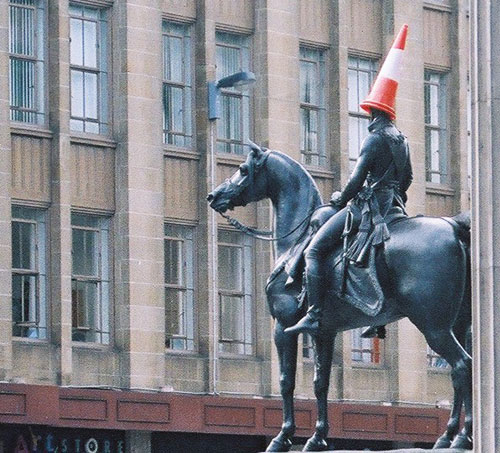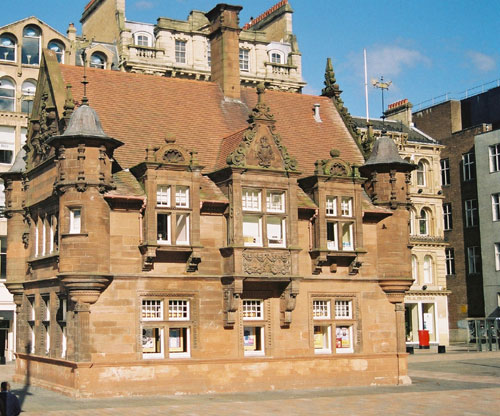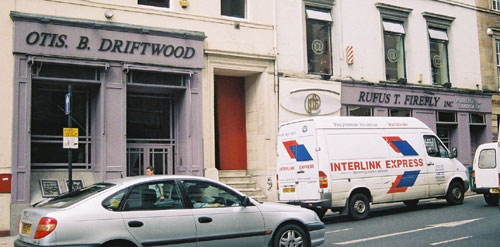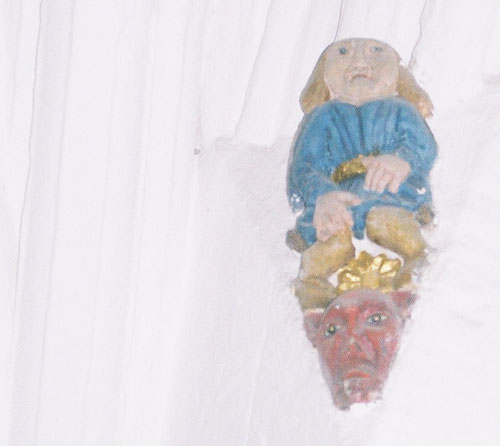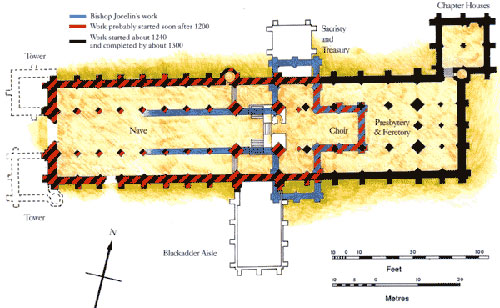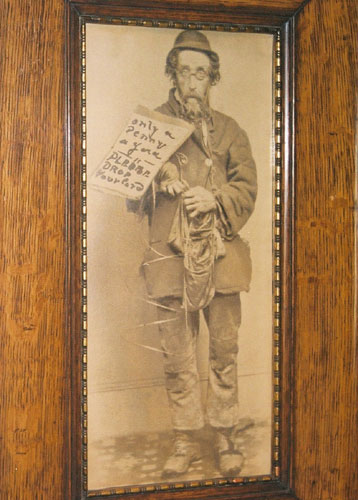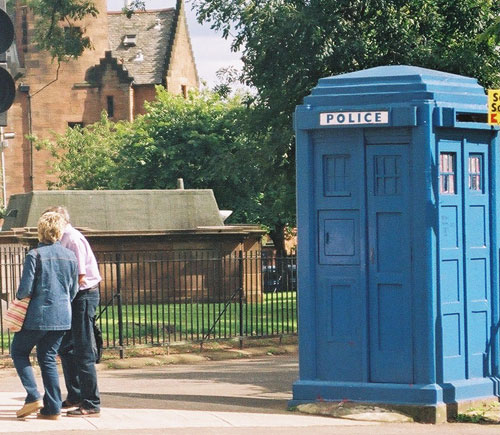Awake at 7. It seems the cabbage had finished boiling as the smell seemed to have vanished over night. The view out of the window was quite dramatic. I mean the sky, not the rooftop. Big, black, threatening clouds, sitting seemingly quite close. The sort of clouds that look solid enough to set up house on.
We left the hotel at 8, having firstly discussed our new room with reception. We were told that since check out wasn’t until 11, we couldn’t change rooms yet but a note would be made of it. Silly things that we are, we figured this was a done deal.
We managed to find a Costa’s coffee shop open next door to the Gallery of Modern Art (GoMA) where we found the Duke of Wellington wearing a rather silly hat, courtesy of some Glasgow drunk from the night before, we assumed.
The staff were very friendly and the coffee was fab – much better than the powdered stuff you get at the Quality Hotel.
We strolled back via numerous shops and busy streets. We found a wonderful travel centre which, it turns out, was originally the ticket office for St Enoch Station.
St Enoch, it appears, was actually St Mungo’s mother, though it depends on who you read as someone claims it was named after a nun who died in 1007. Something in Mungo’s mum’s favour, however, is the fact that Enoch could be a corruption of her name, which was Tannoch. Whichever the person, it’s a lovely building, though very oddly plonked in the middle of a town square.
After spending too much time and money in a book shop, Mirinda decided to argue theology with a Hare Krishna. Poor bugger, he had no idea what he was getting into. I guess it’s because Mirinda looks so sweet. Anyway, we left when she declared his sexism was getting too offensive.
We sat in the hotel lobby for an hour, waiting for Adele, who was fashionably late. She turned up just as I said “How long SHOULD we wait?” She took my wife away so they could have their quality time (not in the hotel) sans kids and husbands, and I set off up to Cathedral Close.
It was not a pleasant walk though the two Groucho Marx signs made me smile. I didn’t find out why they were there and maybe some reader could drop me a line if they do.
First stop was the St Mungo’s Museum of Religious Life and Art. It’s a fantastic concept – reflecting the central importance of religion in human life using artistic and/or textual objects. Unfortunately the rather attractive and informative guide book is a little light on the ground when it comes to facts about the museum. Like when it was built and why. However, the more than helpful piece of paper offered at the Provend’s Lordship tells me that it was once Bishop Cameron’s Tower and opened in 1993.
The museum itself is fantastic and I wholeheartedly recommend it. As the Rough Guide declares, you must see the video first. It is to the right of the desk, in a little room. As well as the history of the gallery, it contains potted interviews with Glaswegians from various religious backgrounds. As a prelude to the museum, it is excellent.
What I found most interesting was the two pieces of vandalism in the museum. Firstly the Dali “Christ of St John of the Cross” was slashed: you can see where the painting has been repaired. Oddly it was slashed, not through the figure of Christ but to the right and below the cross. The only information I can find on this act of vandalism is that no-one knows who, when or why it happened. It was painted in 1951 and the vandalism was discovered about 10 years later.
Secondly, a massive bronze statue of Shiva is so precarious, a screen has been erected in front so it can’t squash anyone foolish enough to come too close. I can’t find anything about the vandalism but it’s interesting that Shiva is the Destroyer and I’ve found mention of other statues of the god having been vandalised elsewhere. Perhaps it’s just what you do. Someone is fixing this one so one day it will be safe enough to remove the barrier.
Outside the museum, and beside the coffee shop, is a small (I stress the word small) zen garden which would be very peaceful and harmonious in a quiet location. Unfortunately it is impossible to ignore the constant traffic noise coming from the street. This is one thing which is obvious at all times and actually spoils the whole place. It’s not just background noise, either, it’s a very loud intrusion and quite awful.
From St Mungo’s I strolled across the Bridge of Sighs and made my way up the necropolis, along paths which meander around ornate memorials and danger-signed crypts, until I reached the top. This is purported to be one of Europe’s great 19th century cemeteries. It is towered over by a quite dominant statue of John Knox perched almost precariously 88 metres up, atop a doric column – you can see him from almost everywhere as you climb up. It is a fantastic place, quite peaceful (though you can still hear the traffic noise) even though there were people wandering round with me. You are high above the industrial city in a world of green, marble and various coloured paints.
Why are some of the memorials spattered with graffiti? Now, I have no problem with the concept of marking things with your initials and a date – the Romans did it everywhere – but what is the point in spray painting ‘wombat’ on some dead Victorian’s gravestone? Steve (who I work with and a self proclaimed authority on Glasgow) reckons it shows how dull Glasgow is on a Saturday night. So do I assume the cemetery is full of bored teenagers with spray cans every weekend night? If so, it’s a shame because it certainly makes you want to leave, as the necropolis now looks tatty and undesirable. If this is one of Europe’s great cemeteries, you really do not want to visit the worst!
From the top I wandered back to the cathedral. I remember St Mungo’s tomb from our previous visit yonks ago but there were lots of parts I had forgotten or that were not open. Blacadder’s Aisle is one particular treasure. It is named after Archbishop Robert Blacadder (and not Rowan Atkinson), Glasgow’s first archbishop way back in 1492. It is a lovely light chapel with quite a low vaulted ceiling making it easy to see the ceiling bosses which are normally hundreds of feet in the air.
Glasgow Cathedral is the only mainland cathedral in Scotland to have survived the aftermath of the Reformation without major structural loss. It stands on a hill and must have had a commanding presence when it was dedicated in 1136. There is nothing left of this church as it burnt down 1186 but it was quickly rebuilt, being once more dedicated in 1197 by Bishop Jocelin. This one, however is also not apparent – though fragments ‘thought’ to be from this church have been found. Sometime around 1200 work began on a completely different plan. Work stopped and started for various reasons and the cathedral was finally ready for roofing around 1300.
The building was then struck by lightening in 1400, splitting the central tower and spire. These were repaired and since then, the church has merely been added to over the centuries.
The layout of the cathedral is unusual as the main part is contained within an elongated rectangle, divided into two more or less equal halves by non-projecting transepts and a central tower above the junction of the parts.
I then walked across the road to the Provand’s Lordship. Originally built as a sandstone tenement with three stories each with three separate chambers and fireplaces, this oddly named place is the oldest house in Glasgow. It is full of nooks, crannies and secret rooms owing to the many changes it has undergone through the centuries. According to the guide sheet, no-one actually knows what the original function of the building was but it is a rare example of 15th century Scottish domestic architecture. Having searched for more information, it seems one theory is that it was built as a manse for the chaplain of St Nicholas Hospital (in Irene Maver’s book, Glasgow). I have my doubts about this, though, as the guide sheet thinks it predates the Hospital.
The odd name comes from a previous tenant form the 19th century, the Prebend of Provan which written fully was ‘Lord of the Prebend of Barlanark’. This was later shortened to ‘Lord of Provan’ and, for some unexplained reason, his house became Provand’s Lordship. This makes very little sense to me but the guide sheet does stress it with some flair and a certain amount of fait a’ccompli.
Upstairs, via the internal spiral staircase, there’s a display of Glaswegian characters of the 19th century including ‘Wee’ Willie White who busked the streets with his tin whistle and was buried in the necropolis by his wealthy fans. And there’s Penny A Yard, a chap who sold lengths of wire at, you guessed it, a penny a yard. He would also twist his wire into puzzles and amuse people. No one really knew why.
Out the back is the lovely St Nicholas Garden. This reflects the buildings possible association with the St Nicholas Hospital. It was created fairly recently (Princess Anne opened it in 1995) but is based on gardens of the 15th century with a physic garden on one side and a celtic knot in the middle. There were also interesting tiles inserted seemingly randomly in the path, each depicting what appeared to be body parts. Adele agreed with me and she’s a doctor so she SHOULD know.
Around the edge of the garden, in a covered cloister area, there are carved grotesque heads dating from 1737, which originally formed the arch keystones of the Tontine Hotel piazza in the Trongate.
It was then time for me to sit and rest in the café and wait for Adele and Mirinda to finish. I bought a coffee and sat beside the zen garden, writing postcards while, unbeknownst to me, they waited inside. Eventually I rang Mirinda’s mobile and after I said “I’m waiting at the coffee bar” to which she replied “No, I’m waiting at the coffee bar” and we figured it all out, we ALL sat in the zen garden.
They popped into the Lord Provend’s place while I went and investigated the Tardis across the road.
We then all walked down to Queen Street station to catch a train to Milgarvie which is pronounced Mull-Guy for some unknown reason. I mean Glasgow isn’t pronounced Glob-Gut, though some may say it so. Adele, Dave and the kids are staying at a friend’s place here in the more tree filled ‘burbs of Glasgow.
I finally got to meet Hamish and Molly and then, after a cup of tea, we retraced our steps back to the station then back to our glorious accommodation to find that because we hadn’t wasted our entire day waiting at reception, we missed our opportunity to change rooms and now the hotel was full again. Of course, this means it’s apparently OUR fault. But we didn’t feel like arguing and left instead to eat dinner at Bella Italia which, although quite clearly part of a chain, had lovely food and excellent service.
Back in our room, Mirinda rang around as many hotels as she could to try and find alternate accommodation but everywhere was full – I assume it’s because of Hamish’s birthday party on Sunday. We watched a smidge of the Olympics then slept.

